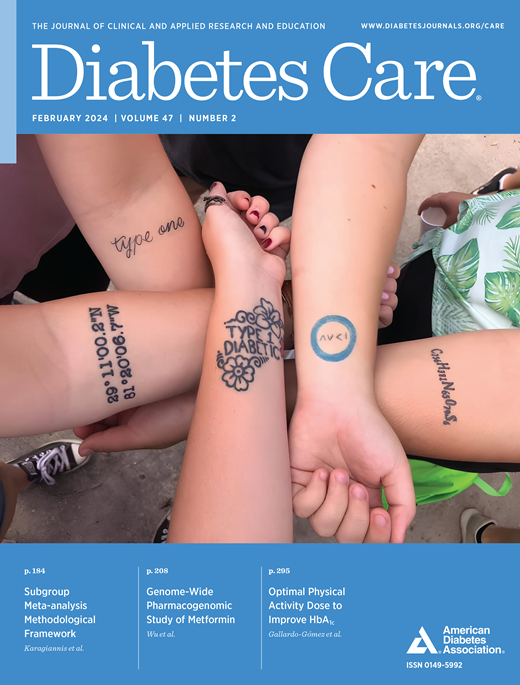Glucagon-Like Peptide 1 Receptor Agonists and the Risk of Emergency Department Visits and Hospitalization in Patients With Chronic Kidney Disease
IF 16.6
1区 医学
Q1 ENDOCRINOLOGY & METABOLISM
引用次数: 0
Abstract
OBJECTIVE The aim of this study was to evaluate the effect of glucagon-like peptide 1 receptor agonist (GLP-1RA) versus dipeptidyl peptidase 4 inhibitor (DPP4i) initiation on emergency department (ED) visits and all-cause hospitalizations across the spectrum of kidney disease. RESEARCH DESIGN AND METHODS This was a retrospective population-based observational cohort study in adults with an estimated glomerular filtration rate <90 mL/min/1.73 m2 using inverse probability of treatment weighting. The Prentice-Williams-Peterson (PWP) gap time model was used for the primary analysis. RESULTS The cohort included 24,576 new users of a GLP-1RA and 23,600 DPP4i new users. GLP1RA initiation was associated with a lower risk of all-cause ED encounters or hospitalizations (hazard ratio [HR] 0.90; 95% CI 0.87–0.94; P < 0.0001). This finding was consistent in confirmatory analyses using the Andersen-Gill model and the PWP calendar time model. CONCLUSIONS GLP-1RA initiation was associated with a reduction in all-cause ED visits and hospitalizations compared with new use of a DPP4i.胰高血糖素样肽1受体激动剂与慢性肾病患者急诊科就诊和住院的风险
目的:本研究的目的是评估胰高血糖素样肽1受体激动剂(GLP-1RA)与二肽基肽酶4抑制剂(DPP4i)启动对急诊科(ED)就诊和全因肾病住院的影响。研究设计和方法:这是一项基于人群的回顾性观察队列研究,研究对象为肾小球滤过率为90 mL/min/1.73 m2的成人,采用治疗加权逆概率法。采用Prentice-Williams-Peterson (PWP)间隙时间模型进行初步分析。该队列包括24,576名GLP-1RA新用户和23,600名DPP4i新用户。GLP1RA起始与全因ED遭遇或住院的风险较低相关(风险比[HR] 0.90;95% ci 0.87-0.94;P, lt;0.0001)。这一发现在使用Andersen-Gill模型和PWP日历时间模型的验证分析中是一致的。结论:与新使用DPP4i相比,GLP-1RA启动与全因ED就诊和住院次数减少有关。
本文章由计算机程序翻译,如有差异,请以英文原文为准。
求助全文
约1分钟内获得全文
求助全文
来源期刊

Diabetes Care
医学-内分泌学与代谢
CiteScore
27.80
自引率
4.90%
发文量
449
审稿时长
1 months
期刊介绍:
The journal's overarching mission can be captured by the simple word "Care," reflecting its commitment to enhancing patient well-being. Diabetes Care aims to support better patient care by addressing the comprehensive needs of healthcare professionals dedicated to managing diabetes.
Diabetes Care serves as a valuable resource for healthcare practitioners, aiming to advance knowledge, foster research, and improve diabetes management. The journal publishes original research across various categories, including Clinical Care, Education, Nutrition, Psychosocial Research, Epidemiology, Health Services Research, Emerging Treatments and Technologies, Pathophysiology, Complications, and Cardiovascular and Metabolic Risk. Additionally, Diabetes Care features ADA statements, consensus reports, review articles, letters to the editor, and health/medical news, appealing to a diverse audience of physicians, researchers, psychologists, educators, and other healthcare professionals.
 求助内容:
求助内容: 应助结果提醒方式:
应助结果提醒方式:


